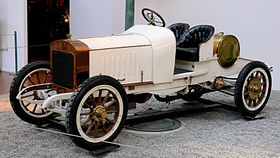De Dietrich Bugatti refers colloquially to a number of early automobile designs by Ettore Bugatti, known as the Types 2 through 7. Importantly, the vehicle known as the Type 2 of 1901 was designed by Bugatti before he joined the automobile manufacturer Lorraine-Dietrich in Niederbronn, Alsace, Germany following its successful reception. Types 3-7 were produced for De Dietrich between 1902 and 1904.
Type 2
Motor vehicle| Bugatti Type 2 | |
|---|---|
 Ettore Bugatti on the Type 2 in 1902 Ettore Bugatti on the Type 2 in 1902 | |
| Overview | |
| Manufacturer | Lorraine-Dietrich |
| Production | 1900-1903 |
| Assembly | Milan |
| Designer | Ettore Bugatti |
| Powertrain | |
| Engine | 3,053 cubic centimetres (186.3 cu in; 3.053 L) Inline 4 |
| Power output | 12 brake horsepower (12 PS; 8.9 kW) 30 newton-metres (22 lbf⋅ft) |
| Transmission | 4-Speed manual |
| Dimensions | |
| Wheelbase | 1,800 millimetres (71 in) |
| Curb weight | 650 kilograms (1,430 lb) |
| Chronology | |
| Predecessor | Bugatti Type 1 |
The Type 2 was a prototype automobile designed and built by Ettore Bugatti in 1901 with financial support from a Count Gulinelli. It won an award at the Milan Trade Fair that year, and gained the notice of Baron Adrien de Turckheim, managing director of the Lorraine-Dietrich automobile factory in Niederbronn in the then-German Alsace.
Type 3, 4, and 5
Motor vehicle| Bugatti Type 3 Bugatti Type 4 Bugatti Type 5 | |
|---|---|
 | |
| Overview | |
| Manufacturer | Lorraine-Dietrich |
| Also called | De Dietrich-Bugatti De Dietrich 24/28 CV (Type 3) De Dietrich 30/35 CV (Type 4) De Dietrich 50/60 CV (Type 5) |
| Production | 1901-1904 |
| Assembly | Niederbronn-les-Bains |
| Designer | Ettore Bugatti |
| Powertrain | |
| Engine | Type 3: 5,308 cubic centimetres (323.9 cu in; 5.308 L) Type 4: 7,433 cubic centimetres (453.6 cu in; 7.433 L) Type 5: 12,868 cubic centimetres (785.3 cu in; 12.868 L) Inline 4 |
| Power output | Type 3: 28 metric horsepower (28 bhp; 21 kW) 45 pound-feet (61 N⋅m) Type 4: 35 metric horsepower (35 bhp; 26 kW) 65 pound-feet (88 N⋅m) Type 5: 60 metric horsepower (59 bhp; 44 kW) 115 pound-feet (156 N⋅m) |
| Transmission | 4-speed (Type 3 and 4) 3-speed (Type 5) |
| Dimensions | |
| Curb weight | 1,000 kilograms (2,200 lb) |
Types 3-4 were Bugatti's initial works for De Dietrich.
Type 6 and 7
Motor vehicle| Bugatti Type 6 Bugatti Type 7 | |
|---|---|
 | |
| Overview | |
| Manufacturer | Mathis |
| Also called | Mathis Hermes Simplex Hermes Bugatti Hermes |
| Production | 1904-1907 |
| Assembly | Illkirch-Graffenstaden |
| Designer | Ettore Bugatti |
| Powertrain | |
| Engine | 7,430 cubic centimetres (453 cu in; 7.43 L) 8,480 cubic centimetres (517 cu in; 8.48 L) 8,986 cubic centimetres (548.4 cu in; 8.986 L) 12,058 cubic centimetres (735.8 cu in; 12.058 L) Inline 4 |
| Power output | 50 brake horsepower (51 PS; 37 kW) 65 pound-feet (88 N⋅m) 60 brake horsepower (61 PS; 45 kW) 75 pound-feet (102 N⋅m) 60 brake horsepower (61 PS; 45 kW) 90 pound-feet (120 N⋅m) 90 brake horsepower (91 PS; 67 kW) 115 pound-feet (156 N⋅m) |
| Transmission | 4-speed manual |
| Dimensions | |
| Wheelbase | 2,930 millimetres (115 in) |
| Length | 4,150 millimetres (163 in) |
| Width | 1,540 millimetres (61 in) |
| Curb weight | 1,100 kilograms (2,400 lb) |
| Chronology | |
| Successor | Bugatti Type 8 |
Types 6 and7 were also designed by Bugatti while with De Dietrich through 1904. Approximately 100 Types 1-7 were produced from 1902 through 1904.
| Bugatti | |||||||||
|---|---|---|---|---|---|---|---|---|---|
| A brand of Bugatti Rimac, a joint venture of Rimac Group and Porsche AG | |||||||||
| Bugatti Automobiles (1998–present) |
| ||||||||
| Bugatti Automobili (1987–95) |
| ||||||||
| Automobiles Ettore Bugatti (1910–62) |
| ||||||||